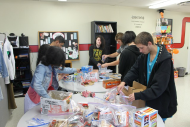March 2016
Initiative, collaboration, relationships form Sioux City recipe for alleviating hunger in secondary schools
 Over 140 middle and high school students in Sioux City are better fed on weekends thanks to the community initiative known as Food 4 Thought. The combined efforts of a diverse team of teachers, administrators, community members, businesses, and a local church provide participating students with supplemental food packs before weekends and school breaks.
Over 140 middle and high school students in Sioux City are better fed on weekends thanks to the community initiative known as Food 4 Thought. The combined efforts of a diverse team of teachers, administrators, community members, businesses, and a local church provide participating students with supplemental food packs before weekends and school breaks.
Though fairly common among elementary schools, supplemental food pack programs are rarer within high schools. The success of the Food 4 Thought model in Sioux City has been emulated by several other districts, including Sergeant Bluff-Luton and a district in Wisconsin. The organizing team publishes a guide for middle and high schools that are interested in emulating the program.
Food 4 Thought overcame several barriers in successfully introducing a food pack program to secondary school students:
Access to Funding: To better access local business and grant funding, Food 4 Thought established an account housed under the nonprofit umbrella of the local Sunnybrook Church.
Avoiding Stigma: The Food 4 Thought program is promoted through signs that are posted in the school, and knowledge typically spreads through word-of-mouth. There is no income testing involved, and promotional materials emphasize how nutrition helps academic performance rather than including language about hunger or food insecurity. Supplemental food packs are distributed through a “self-serve” method. Packs are placed on a countertop in a designated classroom and students come by on their own to pick them up.
School and Community Acceptance: The Food 4 Thought program ensures acceptance by involving a broad cross-section of community members to participate in their activities. Students provide the labor to assemble the food packs. In the high school, students assemble packs once a week during their homeroom. In the middle school, packs are assembled by peer helpers. Most of the budget to purchase food is provided by individuals in the community. Individuals An individual volunteers to shop for the items in bulk at Sam’s Club. Businesses frequently contribute both funds and food.
 The organizers of Food 4 Thought share the following recommendations for success:
The organizers of Food 4 Thought share the following recommendations for success:
If you see a need, act on it. The program began six years ago when a middle school teacher observed a young man who seemed lethargic in class, got to know him, and discovered that he had very little food to eat on weekends and school breaks. She began to offer cereal bars in the morning. Joined by colleagues, she began assembling food packs – initially for seven students. The program blossomed from there.
Network and ask other people for help. The Food 4 Thought program expanded in stages, and each expansion involved additional partners joining the endeavor. Key expansions included the involvement of colleagues to scale up the program to multiple students, help from a church to acquire nonprofit status, and the involvement of community members as donors and volunteers to ensure sustainability.
Emphasize relationships. Older students are often hesitant to ask for help, but needs often become apparent after getting to know them. In addition to the food pack program, teachers at Sioux City East High have established a clothing closet and installed a washer and dryer to better meet students’ needs. Relationships are strengthened by allowing students to not only receive help but also provide service through assembling the meal packs and through an annual holiday canned food drive. Relationships are also critical for increasing community support.
For more information about Food 4 Thought, please contact Ms. Janet Coon at 712-274-4021 or coonj@live.siouxcityschools.com or download their program guide.
Photo Credits: Food 4 Thought students preparing food packs (top), Food 4 Thought students promoting school food drive (bottom)

